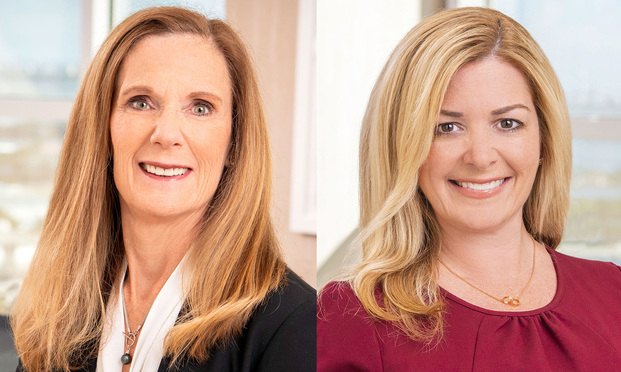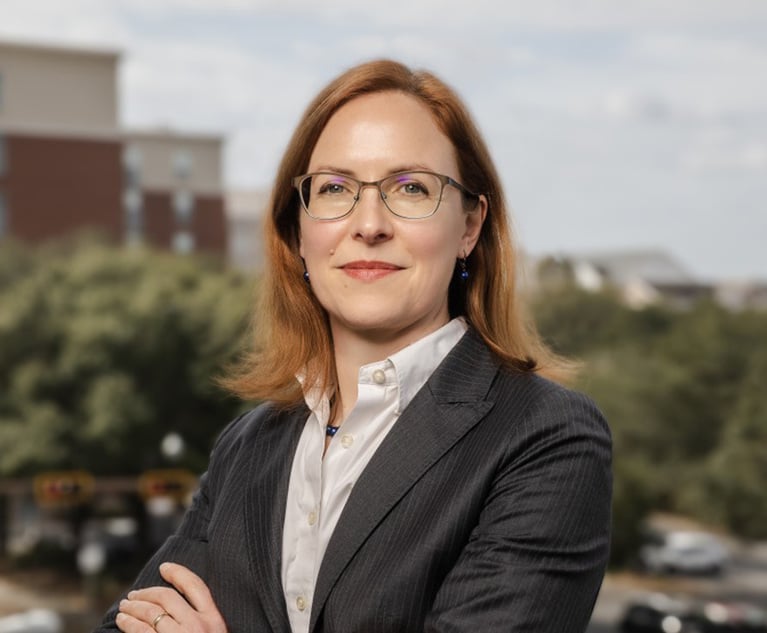Work After COVID-19: What Is the New Normal For Leave, Accommodation Requests?
At least for now, the EEOC intends that ADA accommodation requests will be alive and well post-coronavirus and employers will be required to engaged in the interactive process with each individual.
May 27, 2020 at 10:59 AM
5 minute read
 Susan Eisenberg, left, and Jennifer Williams, right, with Cozen O'Connor.
Susan Eisenberg, left, and Jennifer Williams, right, with Cozen O'Connor.Ever since the federal government issued its three-phased guidance for returning to work in March 2020, employers have been bombarded with questions like: who to recall first; what to do about PPE; how to treat vulnerable employees; how to address current/future requests for accommodation; and what COVID-19-related leave/benefits (if any) do returning employees have left.
Last week, the Equal Employment Opportunity Commission and the Department of Labor both updated their respective employer guidance to more specifically address two issues that will be continually challenging as an organization ramps up staffing: What can employer prepare for in terms of making reasonable accommodations? What continued FFCRA leave (if any) are employees entitled to once they return to work?
At least for now, the EEOC intends that ADA accommodation requests will be alive and well post-coronavirus and employers will be required to engaged in the interactive process with each individual. On the other hand, the DOL envisions parameters to guide continued FFCRA eligibility. Below are the latest examples from both agencies:
Reasonable Accommodations: What's 'Reasonable' Now?
The CDC identifies a number of medical conditions that might place individuals at "higher risk" for severe illness" if they get COVID-19. An employer knows that an employee has one of these conditions and is concern that his health will be jeopardized upon returning to the workplace. How does the ADA apply to this situation?
Even if an employer determines that an employee's disability poses a direct threat to his own health, the employer still cannot exclude the employee from the workplace—or take any other adverse action—unless there is no way to provide a reasonable accommodation (absent undue hardship). The ADA regulations require an employer to consider whether there are reasonable accommodations that would eliminate or reduce the risk so that it would be safe for the employee to return to the workplace while still permitting performance of essential functions. This can involve an interactive process with the employee. If there are not accommodations that permit this, then an employer must consider accommodations such as telework, leave, or reassignment (perhaps to a different job in a place where it may be safer for the employee to work or that permits telework). An employer may only bar an employee from the workplace if, after going through all these steps, the facts support the conclusion that the employee poses a significant risk of substantial harm to himself that cannot be reduced or eliminated by reasonable accommodation.
- What are examples of accommodation that, absent undue hardship, may eliminate (or reduce to an acceptable level) a direct threat to self?
Accommodations may include additional or enhanced protective gowns, masks, gloves, or other gear beyond what the employer may generally provide to employees returning to its workplace. Accommodations also may include additional or enhanced protective measures, for example, erecting a barrier that provides separation between an employee with a disability and coworkers/the public or increasing the space between an employee with a disability and others. Another possible reasonable accommodation may be elimination or substitution of particular "marginal" functions (less critical or incidental job duties as distinguished from the "essential" functions of a particular position). In addition, accommodations may include temporary modification of work schedules (if that decreases contact with coworkers and/or the public when on duty or commuting) or moving the location of where one performs work (for example, moving a person to the end of a production line rather than in the middle of it if that provides more social distancing).
Paid Sick Leave and Family Leave: What Is Left of the FFCRA?
- What documentation may an employer require from an employee who claims to have COVID-19 symptoms and wants to take leave to seek a medical diagnosis?
In order for your employee to take leave under the FFCRA, you may require the employee to identify his or her symptoms and a date for a test or doctor's appointment. You may not, however, require the employee to provide further documentation or similar certification that he or she sought a diagnosis or treatment from a health care provider in order for the employee to use paid sick leave for COVID-19-related symptoms. The minimal documentation required to take this leave is intentional so that employees with COVID-19 symptoms may take leave and slow the spread of COVID-19.
- After completing distance learning, the children's school closed for summer vacation. May an employee take paid sick leave or expanded family and medical leave under the FFCRA to care for his children in this situation?
No. Paid sick leave and emergency family and medical leave are not available for this qualifying reason if the school or child care provider is closed for summer vacation, or any other reason that is not related to COVID-19.
Susan Eisenberg is managing partner of the Miami office of Cozen O'Connor. She and Jennifer T. Williams are members of the firm. Both represent employers in labor and employment matters.
This content has been archived. It is available through our partners, LexisNexis® and Bloomberg Law.
To view this content, please continue to their sites.
Not a Lexis Subscriber?
Subscribe Now
Not a Bloomberg Law Subscriber?
Subscribe Now
NOT FOR REPRINT
© 2025 ALM Global, LLC, All Rights Reserved. Request academic re-use from www.copyright.com. All other uses, submit a request to asset-and-logo-licensing@alm.com. For more information visit Asset & Logo Licensing.
You Might Like
View All
Essential Labor Shifts: Navigating Noncompetes, Workplace Politics and the AI Revolution

Initial Steps to Set Up a Fla. Appeal: Your Future Self (or Appellate Attorney) Will Thank You
6 minute read
Divorce Timing Is Everything: Waiting for the New Year May Have Its Advantages
4 minute read
Motions for Summary Judgment and Discovery: The 2021 Rule Changes Continue to Emerge
5 minute readLaw Firms Mentioned
Trending Stories
- 1'It's Not Going to Be Pretty': PayPal, Capital One Face Novel Class Actions Over 'Poaching' Commissions Owed Influencers
- 211th Circuit Rejects Trump's Emergency Request as DOJ Prepares to Release Special Counsel's Final Report
- 3Supreme Court Takes Up Challenge to ACA Task Force
- 4'Tragedy of Unspeakable Proportions:' Could Edison, DWP, Face Lawsuits Over LA Wildfires?
- 5Meta Pulls Plug on DEI Programs
Who Got The Work
Michael G. Bongiorno, Andrew Scott Dulberg and Elizabeth E. Driscoll from Wilmer Cutler Pickering Hale and Dorr have stepped in to represent Symbotic Inc., an A.I.-enabled technology platform that focuses on increasing supply chain efficiency, and other defendants in a pending shareholder derivative lawsuit. The case, filed Oct. 2 in Massachusetts District Court by the Brown Law Firm on behalf of Stephen Austen, accuses certain officers and directors of misleading investors in regard to Symbotic's potential for margin growth by failing to disclose that the company was not equipped to timely deploy its systems or manage expenses through project delays. The case, assigned to U.S. District Judge Nathaniel M. Gorton, is 1:24-cv-12522, Austen v. Cohen et al.
Who Got The Work
Edmund Polubinski and Marie Killmond of Davis Polk & Wardwell have entered appearances for data platform software development company MongoDB and other defendants in a pending shareholder derivative lawsuit. The action, filed Oct. 7 in New York Southern District Court by the Brown Law Firm, accuses the company's directors and/or officers of falsely expressing confidence in the company’s restructuring of its sales incentive plan and downplaying the severity of decreases in its upfront commitments. The case is 1:24-cv-07594, Roy v. Ittycheria et al.
Who Got The Work
Amy O. Bruchs and Kurt F. Ellison of Michael Best & Friedrich have entered appearances for Epic Systems Corp. in a pending employment discrimination lawsuit. The suit was filed Sept. 7 in Wisconsin Western District Court by Levine Eisberner LLC and Siri & Glimstad on behalf of a project manager who claims that he was wrongfully terminated after applying for a religious exemption to the defendant's COVID-19 vaccine mandate. The case, assigned to U.S. Magistrate Judge Anita Marie Boor, is 3:24-cv-00630, Secker, Nathan v. Epic Systems Corporation.
Who Got The Work
David X. Sullivan, Thomas J. Finn and Gregory A. Hall from McCarter & English have entered appearances for Sunrun Installation Services in a pending civil rights lawsuit. The complaint was filed Sept. 4 in Connecticut District Court by attorney Robert M. Berke on behalf of former employee George Edward Steins, who was arrested and charged with employing an unregistered home improvement salesperson. The complaint alleges that had Sunrun informed the Connecticut Department of Consumer Protection that the plaintiff's employment had ended in 2017 and that he no longer held Sunrun's home improvement contractor license, he would not have been hit with charges, which were dismissed in May 2024. The case, assigned to U.S. District Judge Jeffrey A. Meyer, is 3:24-cv-01423, Steins v. Sunrun, Inc. et al.
Who Got The Work
Greenberg Traurig shareholder Joshua L. Raskin has entered an appearance for boohoo.com UK Ltd. in a pending patent infringement lawsuit. The suit, filed Sept. 3 in Texas Eastern District Court by Rozier Hardt McDonough on behalf of Alto Dynamics, asserts five patents related to an online shopping platform. The case, assigned to U.S. District Judge Rodney Gilstrap, is 2:24-cv-00719, Alto Dynamics, LLC v. boohoo.com UK Limited.
Featured Firms
Law Offices of Gary Martin Hays & Associates, P.C.
(470) 294-1674
Law Offices of Mark E. Salomone
(857) 444-6468
Smith & Hassler
(713) 739-1250






